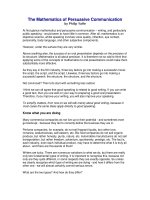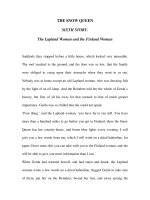Tài liệu The Mathematics of Persuasive Communication ppt
Bạn đang xem bản rút gọn của tài liệu. Xem và tải ngay bản đầy đủ của tài liệu tại đây (50.97 KB, 8 trang )
The Mathematics of Persuasive Communication
by Philip Yaffe
At first glance mathematics and persuasive communication – writing, and particularly
public speaking - would seem to have little in common. After all, mathematics is an
objective science, whilst speaking involves voice quality, inflection, eye contact,
personality, body language, and other subjective components.
However, under the surface they are very similar.
Above anything else, the success of an oral presentation depends on the precision of
its structure. Mathematics is all about precision. It is therefore not so odd to think that
applying some of the concepts of mathematics to oral presentations could make them
substantially more effective.
As they say in the film industry, three key factors go into making a successful movie:
the script, the script, and the script. Likewise, three key factors go into making a
successful speech: the structure, the structure, and the structure.
Not convinced? Then let's start with something less radical.
I think we can all agree that good speaking is related to good writing. If you can write
a good text, then you are well on your way to preparing a good oral presentation.
Therefore, if you improve your writing, you will also improve your speaking.
To simplify matters, from now on we will talk mainly about good writing, because in
most cases the same ideas apply directly to good speaking.
Know what you are doing
Many commercial companies do not live up to their potential - and sometimes even
go bankrupt - because they fail to correctly define the business they are in.
Perfume companies, for example, do not sell fragrant liquids, but rather love,
romance, seductiveness, self-esteem, etc. Bio-food companies do not sell organic
produce, but rather honesty, purity, nature, etc. Automobile manufacturers do not sell
transportation, but rather freedom, adventure, spontaneity, prestige, etc. The fact is,
each industry, even each individual product, may have to determine what it is truly all
about - and there are thousands of them!
Writers are lucky. There are numerous variations to what we do, but there are really
only two fundamental types of writing. It is important to recognise this, because not
only are they quite different, in some respects they are exactly opposite. So unless
we clearly recognise which type of writing we are doing - and how it differs from the
other one - we will almost certainly commit serious errors.
What are the two types? And how do they differ?
Creative Writing
Texts such as short
stories, novels,
poems, radio plays,
stage plays,
television scripts, film
scripts, etc.
The fundamental
purpose of creative
writing is to amuse
and entertain.
Expository Writing
Texts such as memos,
reports, proposals,
training manuals,
newsletters, research
papers, etc.
The fundamental
purpose of expository
writing is to instruct and
inform.
Essential attitude towards expository writing
Because the objectives of creative and expository writing are so different, before
striking a key you must adopt the appropriate attitude towards the type of writing you
are doing.
Creative writing attitude
Everyone wants to read want what you are going to write.
After all, who doesn't want to be amused and entertained?
Expository writing attitude
No one wants to read what you are going to write.
Most people don't like to be instructed and informed. They probably would much
prefer to be doing something else.
The importance of recognising and adopting the "expository writing attitude" cannot
be over-stated, because it can dramatically change the very nature of what you are
writing. Here are a couple of examples.
A. Corporate image brochure
I was once commissioned to write a corporate image brochure. Two things are
certain about these expensive, glossy booklets:
•
Almost all companies of any size feel compelled to produce them.
•
Virtually no one ever reads them.
Starting from the attitude that no one would want to read what I was about to write, I
created a brochure that people not only read. They actually called the company to
request additional copies to give to friends, clients and professional colleagues!
B. Stagnating product
On another occasion, I was commissioned to develop an advertising campaign to
revitalise a product with stagnating sales. Applying the expository writing attitude, I
discovered that three of the product's key benefits were not being properly exploited.
Why? The manufacturer felt that everything about their product was important, so for
years they had been systematically burying these three key benefits under an
avalanche of other information of less interest to potential buyers. The new campaign
sharply focussed on the key benefits; virtually all other information was moved to the
background or eliminated. As a result, sales shot up some 40% in the first year.
With some nuances, this self-same expository writing attitude can be - and should be
- applied to speaking, as well.
Essential approach to expository writing
Because creative writing and expository writing have essentially different objectives
and attitudes, they require essentially different approaches.
Creative writing approach
Play with language to generate pleasure.
In other words, use your mastery of the language to amuse and entertain.
Expository writing approach
Organise information to generate interest.
Clever use of language will never make dull information interesting; however, you can
organise the information to make it interesting. Forget about literary pyrotechnics.
Concentrate on content.
We are now going to leave creative writing, because most of what we write, and say,
is expository.
What do we mean by "good writing"?
We are now ready to return to the notion of how mathematics applies to good writing,
and by extension to good speaking.
When someone reads an expository text or listens to an expository speech, they are
likely to judge it as good or not good. You probably do this yourself. But what do you
actually mean when you say a text or a speech is "good".
After some struggling, most people will usually settle on two criteria: clear and
concise.
Mathematics depends on unambiguous definitions; if you are not clear about the
problem, you are unlikely to find the solution. So we are going to examine these
criteria in some detail in order to establish objective definitions - and even quasi-
mathematical formulae - for testing whether a text or a presentation truly is "good".
A. Clarity
How do you know that a text is clear?
If this sounds like a silly question, try to answer it. You will probably do something like
this:
Question: What makes this text clear?
Answer: It is easy to understand.
Question: What makes it easy to understand?
Answer: It is simple.
Question: What do you mean by simple?
Answer: It is clear.
You in fact end up going around in a circle. The text is clear because it is easy to
understand . . . because it is simple . . . because it is clear.
"Clear", "easy to understand", and "simple" are synonyms. Whilst synonyms may
have nuances, they do not have content, so you are still left to your own subjective
appreciation. But what you think is clear may not be clear to someone else.
This is why we give "clear" an objective definition, almost like a mathematical
formula. To achieve clarity -i.e. virtually everyone will agree that it is clear - you must
do three things.
1. Emphasise what is of key importance.
2. De-emphasise what is of secondary importance.
3. Eliminate what is of no importance.
In short:
C
L
= EDE
Like all mathematical formulae, this one works only if you know how to apply it, which
requires judgement.
In this case, you must first decide what is of key importance, i.e. what are the key
ideas you want your readers to take away from your text? This is not always easy to
do. It is far simpler to say that everything is of key importance, so you put in
everything you have. But there is a dictum that warns: If everything is important, then
nothing is. In other words, unless you first do the work of defining what you really
want your readers to know, they won't do it for you. They will get lost in your text and
either give up or come out the other end not knowing what it is they have read.
What about the second element of the formula, de-emphasise what is of secondary
importance?
That sounds easy enough. You don't want key information and ideas to get lost in
details. If you clearly emphasise what is of key importance - via headlines, Italics,
underlining, or simply how you organise the information - then whatever is left over is
automatically de-emphasised.
Now the only thing left to do is eliminate what is of no importance.
But how do you distinguish between what is of secondary importance and what is of
no importance? Once again, this requires judgement, which is helped by the following
very important test.
Secondary importance is anything that supports and/or elaborates one or more of
the key ideas. If you judge that a piece of information in fact does support or
elaborate one or more key ideas, then you keep it. If not, you eliminate it.
B. Conciseness
How do you know that a text is concise?
If this once again sounds like a silly question, let's try to answer it.
Question: What makes this text concise?
Answer: It is short.
Question: What do you mean by short?
Answer: It doesn't have too many words.
Question: How do you know it doesn't have too many words?
Answer: Because it is concise.
So once again we end up going around in a circle. The text is concise because it is
short . . . because it doesn't have too many words . . . because it is concise.
Once again, we have almost a mathematical formula to solve the problem. To
achieve conciseness, your text should meet two criteria. It must be as:
1. Long as necessary
2. Short as possible
In symbols:
C
O
= LS
If you have fulfilled the criteria of "clarity" correctly, you already understand "as long
as necessary". It means covering all the ideas of key importance you have identified,
and all the ideas of secondary importance needed to support and/or elaborate these
key ideas.
Note that nothing is said here about the number of words, because it is irrelevant. If it
takes 500 words to be "as long as necessary", then 500 words must be used. If it
takes 1500 words, then this is all right too. The important point is that everything that
should be in the text is fully there.
Then what is meant by "as short as possible"?
Once again, this has nothing do to with the number of words. It is useless to say at
the beginning, "I must not write more than 300 words on this subject", because 500
words may be the minimum necessary.
"As short as possible" means staying as close as you can to the minimum. But not
because people prefer short texts; in the abstract the terms "long" and "short" have









